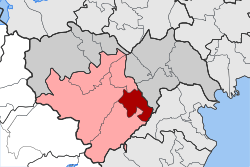Vergina
|
Vergina Βεργίνα |
|
|---|---|

Great Tumulus of Aigai
|
|
| Coordinates: 40°29′N 22°19′E / 40.483°N 22.317°ECoordinates: 40°29′N 22°19′E / 40.483°N 22.317°E | |
| Country | Greece |
| Administrative region | Central Macedonia |
| Regional unit | Imathia |
| Municipality | Veroia |
| • Municipal unit | 69.0 km2 (26.6 sq mi) |
| Lowest elevation | 120 m (390 ft) |
| Population (2011) | |
| • Municipal unit | 2,464 |
| • Municipal unit density | 36/km2 (92/sq mi) |
| Community | |
| • Population | 1,242 (2011) |
| Time zone | EET (UTC+2) |
| • Summer (DST) | EEST (UTC+3) |
| Archaeological Site of Aigai (mod. name Vergina) | |
|---|---|
| Name as inscribed on the World Heritage List | |
 |
|
| Location | Greece |
| Type | Cultural |
| Criteria | i, iii |
| Reference | 780 |
| UNESCO region | Europe and North America |
| Inscription history | |
| Inscription | 1996 (20th Session) |
Vergina (Greek: Βεργίνα [verˈʝina]) is a small town in northern Greece, located in the regional unit of Imathia, Central Macedonia. Since the 2011 local government reform it is part of the municipality Veroia, of which it is a municipal unit. The municipal unit has an area of 69.047 km2.
The town is better known for its remains of Valla, and ancient city of Pieria. It was here in 336 BC that Philip II was assassinated in the theatre and Alexander the Great was proclaimed king.
Aigai has been awarded UNESCO World Heritage Site status as "an exceptional testimony to a significant development in European civilization, at the transition from classical city-state to the imperial structure of the Hellenistic and Roman periods".
It became internationally famous in 1977, when the Greek archaeologist Manolis Andronikos unearthed the burial site of the kings of Macedon, including the tomb of Philip II, father of Alexander the Great which unlike so many other tombs had not been disturbed or looted. It is also the site of an extensive royal palace and of many rich ancient tombs. A museum now contains Philip's tomb and a new museum is being constructed for the palace and other finds. The objects and paintings found in the tombs at Vergina are also of extraordinarily high quality and historical importance.
During the 8th and 7th century BC the area around Vergina was ruled by Illyrian tribes. Most scholars now believe that the Macedonians expelled the Illyrians and then established their capital at Aigai.
...
Wikipedia


